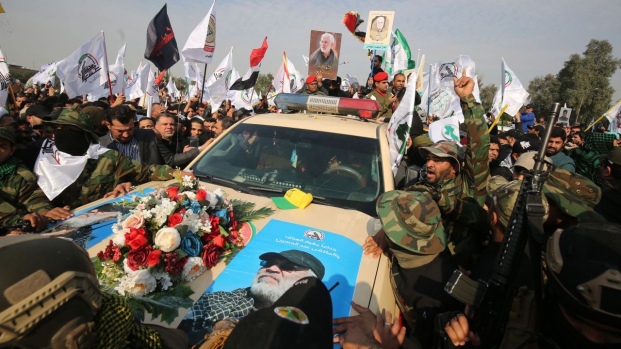By Chloe CornishJanuary 20, 2020
At the time, as the United States and Iran exchanged threats of mutual destruction, little attention was paid to the death of the 66-year-old Iraqi fighter, for years a thorn in Washington’s side. But as the dust settles on the first round of Iranian retaliation, Iraqi officials and Western experts warn that al-Muhandis’ killing has rocked Iraq’s powerful network of Shiite militias, weakening Iran’s influence in the country while also increasing the risk of militia violence and reprisals against U.S. targets.
Born in Basra, al-Muhandis led Kata’ib Hizbollah, one of the most radical Iran-backed paramilitary groups, through which Tehran has dramatically increased its influence in Iraq over the past decade. In 2017, he was appointed deputy commander of an umbrella paramilitary group, the Popular Mobilization Forces (PMF), created as Baghdad sought to bring the myriad militias that fought against ISIS under the command of the armed forces.
The PMF stands at some 140,000 salaried militiamen and boasts one of the largest blocs in Parliament, the Fatah coalition. But the backbone of the group remains battle-hardened Shiite militias, trained and funded by Tehran, who previously fought American troops in Iraq and call themselves “resistance groups.”
[Al-Muhandis and Soleimani] have acted both as an accelerator [and] brake on attacks as it fits their interests.
Douglas Silliman, former U.S. ambassador to Iraq
Al-Muhandis, a nom de guerre meaning “engineer,” “orchestrated primarily the resistance camp, the pro-Iranian group,” and was a close ally of Tehran for decades, says a senior Iraqi official.
The death of al-Muhandis has paved the way for a succession struggle between several ambitious militia leaders in the PMF with diverging political agendas. Such leaders include cleric-turned-paramilitary-head Muqtada al-Sadr; Qais al-Khazali, leader of Iran-linked Asa’ib Ahl al-Haq; and Hadi al-Amiri, the Fatah coalition leader.
Nasr al-Shammari, a spokesperson for one of the Shiite militias under al-Muhandis’ influence, says no decision has been made about who will replace him. “The resistance and [PMF] has not only tens of men but hundreds … who can take on the position,” he says.
In the first instance, though, the militia heads have a common goal: avenging al-Muhandis by achieving his long-stated aim of forcing the U.S. out of Iraq. At the political level in Baghdad, his assassination has already galvanized Shiite Islamist politicians to push through a parliamentary decision in favor of removing foreign troops the country.
Mike Pompeo, U.S. secretary of state, told an audience at Stanford University last week that he had made some 50 calls to Iraqi leaders over the past 10 days in a bid to shore up the U.S. position in the country.
Current and former U.S. officials are generally positive about al-Muhandis’ death even though the evidence released so far suggests the Iraqi leader was not a primary target. “[The killing of al-Muhandis was] a surprise but a good one,” says a senior U.S. official.
Al-Muhandis was viewed as Soleimani’s right-hand man in Iraq.Washington had designated his militia group a terrorist organization and, in 2009, sanctioned him over attacks on American troops occupying Iraq. Separately, Kuwait charged him in absentia with the 1983 bombing of the U.S. Embassy and Kuwaiti infrastructure.
“They don’t have an organizing brain anymore,” says Michael Knights, a senior fellow at the Washington Institute, a think tank that advocates countering Iranian influence in the Middle East.
But without the two strongmen, Iraqis also fear the possible return of bloody intra-Shiite militia conflicts that followed the U.S.-led invasion in 2003, battles that hurt civilians and destabilized Iraq’s oil-rich south.
Others argue that al-Muhandis also had the strategic sense to temper some of the more extreme anti-American militias. “[Al-Muhandis and Soleimani] have acted both as an accelerator [and] brake on attacks as it fits their interests,” says Douglas Silliman, a former U.S. ambassador to Iraq, citing the downturn in militant attacks in 2011 as the U.S. withdrew from Iraq, and the cessation of hostilities toward American forces during the 2014–17 ISIS battle.
The senior Iraqi official says a weakened PMF command structure may provide greater scope for rogue militants to mount attacks on U.S. installations. He forecasts “friction, competition, ambiguity, lack [of] clarity of decision-making” without al-Muhandis corralling PMF factions.
Even before al-Muhandis’ death, tensions between Shiite militias were unnerving Iraqi military officials, as fault lines emerged in their response to the massive anti-government protests that have swept Iraq since October.
While some militia groups were accused of intimidating and murdering protesters, others were prepared to guard the demonstrators, clashing with unidentified militants during some of the deadliest days of violence.
“The situation is very dangerous,” Yehia Rasool, Defense Ministry spokesperson, told this reporter in Baghdad in December during a brief lull in the protests, which have so far left some 500 people dead. Rasool warned of “a sea of blood” should intra-Shiite militia rivalries boil over.
By Chloe Cornish
OZY partners with the U.K.’s Financial Times to bring you premium analysis and features. © The Financial Times Limited 2019.
No comments:
Post a Comment